On Exudation of Gum Arabic through Advance Technology
JC Tewari1*, Kamlesh Pareek1, Shiran K1 and Niranjan Prasad2
1Division of Integrated Land use Management and Farming System, ICAR-Central Arid Zone Research Institute, India
2ICAR-Indian Institute of Natural Resins and Gums, Namkum, Ranchi, India
Submission: April 29, 2017; Published: June 14, 2017
How to cite this article: JC Tewari, Kamlesh P, Shiran K, Niranjan P. On Exudation of Gum Arabic through Advance Technology. Int J Environ Sci Nat 02 Res. 2017; 2(5): 555596. DOI: 10.19080/IJESNR.2017.02.555596
Abstract
Acacia senegal (L.) Willdenow or Acacia seyal (Fam. Leguminosae) is an important species, the source of gum Arabic is found in the desert state of Rajasthan, especially in arid western Rajasthan. It's habitats in arid western Rajasthan included rocky hills, sandy plains, sandy hummock and sand dunes. It is commonly an under canopy tree which generally attains a height of 4.5 to 8.0 m. After repeated trials and error, ICAR-CAZRI, Jodhpur standardized the dose of Ethephon treatment of A. senegal trees for enhanced recovery of gum Arabic. The present study deals with CAZRI developed gum Arabic production technology; and gum production pattern, effect of management practices coupled with CAZRI gum inducer treatment on gum Arabic production in rocky land form, gum production from A. senegal in relation to tree basal area, temperature vs. gum yield, gum Arabic production from different land forms in arid zone, and extension and adoption of CAZRI gum exudation technology. From the data obtained through various experimentations and regarding adoption of technology clearly indicated that the species can be source of additional income for the millions of people in arid and semi-arid regions of India, if it is explored scientifically for gum tapping through the technique developed by ICAR-Central Arid Zone Research Institute, Jodhpur, India.
Introduction
Acacia senegal is native to arid and semi arid region of sub- Saharan Africa. In Indian sub-continent species is exotic but has been well naturalized.Champion & Seth [1] placed A. senegal (L.) Willdenow or Acacia seyal (Fam. Leguminosae) FAO [2] is under dry tropical thorn forest in their classification of Indian forests. This important species is found in the desert state of Rajasthan, especially in arid western Rajasthan. It's habitat in arid western Rajasthan included rocky hills, sandy plains, sandy hummocks and sand dunes. It is also found in other parts of India viz., of south-east Punjab, Gujarat, Madhya Pradesh, Maharastra and Haryana. In extreme western fringes of arid western Rajasthan the species forms important component of traditional agro forestry system [3].
A. sengal is commonly under canopy trees which generally attains height of 4.5 to 8.0 m however, in most conducive environmental conditions it can attain height up to 14-15 m. Trunk may vary in diameter often attain a diameter of 25 -35 cm. Bark is grayish white, although in some mature old trees it may be dark, scaly and thin. Powerful hooked thorns, 3-5 mm long, with enlarged bases appear at the nodes of the branches, usually in like 3s. They are sharp, with some pointing forwards and others backwards. Leaves bipinnate (3-8 pinnae), flowers yellowish -white and fragrant. Each flower has five deep lobes, 5 petals, a mass of short stamens and pistil inconspicuous. The pods are straight, flate, shortly stipitate and oblong, green when young, maturing to shining brown. Each pod contains 3-6 seeds which are smooth, flat, rather small, shiny dark brown. Seeds are also source of traditional folk vegetable. The species has wide ecological amplitude [4].
In India, it grows on the dry rocky and semi-rocky terrains of Haryana and Punjab; foot hills of Aravali; parts of Gujarat, Maharashtra and Madhya Pradesh; and arid western part of Rajasthan. In arid western Rajasthan, it grows abundantly in different habitats like rocky, semi-rocky, sandy plains and dunes of old formation. A. senegal is main tree component in rocky land forms of arid western Rajasthan. Rocky-semi-rocky land forms are spread over in 12% area of arid western Rajasthan which accounted to be 23,520 sq km. In such land forms A. senegal can be a source of income to the farmers if they get some quantity of gum from the trees. The species is known for its edible high quality gum, commonly known as gum Arabic. Gum Arabic is "dried exudates" obtained from the stems and branches of the species [2]. India has been a net importer ever since gum Arabic trade has got in its present shape in organized form. Imports, mainly from Sudan and Nigeria (the top gum Arabic producers), are needed to meet the country's requirements. Imports have increased from 4048 tons in 1992 to 26,098 tons in 2011 UN Data [5].
India has the potential to produce independently a much higher quantum of gum Arabic because A. Senegal trees are distributed abundantly throughout the arid and semi-arid tropics which constitute approximately 40% of the geographical area of the country. The most important issue is that this rich natural source of the country has left mostly un-tapped because in traditional gum tapping method in which the tree trunks are blazed as various parts of the stem results in production of only 15-45 g gum Arabic/ tree, which is not economically viable and as well as harmful for tree health.
Ethephon (2-chloroethylphosphonic acid) is a synthetic compound of ethylene, phosphate and chloride ions. It is a commonly known as plant growth regulator. In plant increased rates of ethylene biosynthesis induced by stress activate various developmental responses and gum exudation may be considered as one such developmental response to stress [6]. The idea to use Ethephon as gum inducer came from the thought that if ethylene is supplied artificially to the tree via the application of Ethephon, the developmental response to stress could be accelerated, and, consequently, more gum exudates could be obtained. On the basis of this assumption, ICAR- Central Arid Zone Research Institute (ICAR-CAZRI), Jodhpur developed a technology to exude higher quantum of gum Arabic from abundantly distributed A. Senegal tress in arid western Rajasthan. Paper describes CAZRI gum exudation technology and different experimentations carried out using this technology, and as well as extension and adoption of the technology by the stakeholders.
About Arid Western Rajasthan
Hot arid regions of India lies between 24-29o North latitude and 70-76o East longitude covering an area of 317000 sq. km, which are spread over in the state of Rajasthan, Gujarat, Haryana, Punjab, Telangana, Maharashtra and Karnataka. Arid western Rajasthan which cover an area of 196000 sq km (about 61% of total area of Indian hot arid zone) of Indian hot arid zone is considered as principal hot arid region of country. Production and life support system in arid western Rajasthan are constrained by climatic limitations such as, low annual precipitation (100300 mm/year); very high summer temperature touching a maximum sometimes 48o-50oC; short cool and dry winters; high wind speed (30 to 40 km/hours); high evapo-transpiration; and low humidity (aridity index 0.045- 0.19). [7]. Abnormal rainfall and droughts are common features of the tract. Sand dunes are dominant land form. In general soil contains 1.8-4.5 % clay, 0.41.3% silt, 63.7-87.3% fine sand and 14.3 -30.3% coarse sand. These soils are poor in fertility throughout the tract. Despite of inhospitable environment, area is rich in vegetation. It is considered most vegetated desert of the world having more than 600 plant species [8]. A. Senegal, the source of gum Arabic is found prominently in extreme western part of arid western Rajasthan however, it is also distributed in many other arid and semi-arid areas of the state.
Material and Methods
The Technology
After repeated trials and error, ICAR-CAZRI, Jodhpur standardized the dose of Ethephon treatment of A. Senegal trees for enhanced recovery of gum Arabic. It was found that Ethephon solution containing 780 mg active ingredient/4 ml was found optimum dose for maximum yield of gum Arabic. The standardized Ethephon solution for gum Arabic production is giving the name- CAZRI gum inducer. Application of CAZRI gum inducer on A. Senegal trees was done as follows.
A 50o downward slanted hole of 14- 16 mm in diameter and about 4 cm deep was made on the tree trunk (35-50 cm above the ground) using a hand or electrical drill. This technique was used to ensure that maximum amount of the applied CAZRI gum inducer was utilized by the tree for the process of gum exudation. One 4-ml dose of CAZRI gum inducer is applied. After the treatment, the hole was covered with moistened clay/ natural bee wax. Whole procedure of ethephon-induced gum Arabic exudation technique is shown in (Figure 1). In this method Ethephon which is directly injected into the tree trunk reaches rapidly in plant tissues involved in gum production.
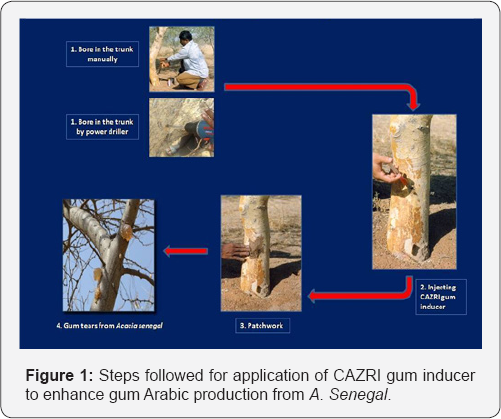
Gum Production Pattern
Twenty five trees of A. Senegal were having more or less similar diameter at breast height (DBH) and tree height were treated by CAZRI gum inducer in mid- March of 2011 as the method described above. Gum Arabic production from these trees was monitored till the exudation of gum Arabic was stopped.
Effect of Management Practices Coupled with CAZRI Gum Inducer Treatment on Gum Arabic Production in Rocky Land Form
About 12152 sq km geographical area of arid western Rajasthan is rocky-gravelly distributed in many pockets. In such land form only A. Senegal was prominently found. No other tree species grows in this land form. It was very interesting to understand whether gum production from A. Senegal occurs in such areas by adopting CAZRI gum induction technique. Therefore, a replicated experiment was laid out on rocky range land of Bhopalgarh area of arid wester Rajasthan, which was located in Jodhpur district (under jurisdiction of ICAR-CAZRI) to assess the gum production from even aged Acaica Senegal trees with and without management practices in factorial randomised block design with 3 replications.
Treatments comprised of 2 factors. Factor one consisted of 3 levels of management practices viz., irrigation, manuring and irrigation + manuring with absulute controls (no CAZRI inducer treatment was given, only trees were blazed by traditional method). Factor 2 consisted of 2 concentrations of gum inducer viz., half concentration of normal dose (2ml of CAZRI gum inducer) and normal dose (4 ml of CAZRI gum inducer).
Gum Production from A. Senegal in Relation to Tree Basal Area
An experiment was carried out in silvatum of CAZRI, Jodhpur where soil is shallow with murum layer just below 1.0 meter depth. Seventy trees of A. Senegal of uniform age having different DBH were selected to form seven DBH classes. Thus, each DBH classes was represented by ten trees (DBH= 20-30 to >90 having interval of 10 cm) which were treated as per standard procedure using 4 ml of CAZRI gum inducer during first week of April, 2013. Gum exudation was initiated ten day after the treatment was employed and continued up to 4 weeks.
Temperature Vs Gum Yield
Study was carried out during 2014 to understand relationship between gum Arabic yield and temperature. Thirty five trees of A. Senegal were selected. These trees were having uniform age (14 years), and more or less similar stem diameter (19.7-21.0 cm). Trees were treated by CAZRI gum inducer in different months i.e. from January to June and monthly mean maximum and minimum temperature was recorded precisely during the experimentation periods.
Gum Arabic Production from Different Land Forms in Arid Zone
In arid western Rajasthan, different types of land forms are found. Arid western Rajasthan is spread over approximately 196000 sq km, which is better known as Thar desert [8]. A. Senegal is wide spread on different land forms. Of the total geographical area of arid western Rajasthan 47.9 % is under different intensities of dunes and inter-dunal planes. Sandy planes are spread over in 27.9 % area. Rocky-gravelly areas are spread over in 11.6 %. Rest 12.6% area is under other different land forms in which A. Senegal is not found at all. A study was conducted in 2014 on five major land formations of arid zone in five villages of Chouhatan tehsil and Barmer tehsil of Barmer district, and Shergarh tehsil of Jodhpur district. The selection of villages was done on the basis of dominant land form in a particular village (Binjarad, dominant formation sand dunes; Jakhada, dominant formation was inter dunal areas; Chatarpura dominant formation was rocky-gravelly land; Sura and Bayatu, dominant formation was sandy plain. In each land form, 25 trees of more or less same girth class were marked and treated with CAZRI gum inducer and information on gum production was collected from the stakeholders at the end of June (at the start of rainy season).
Extension and adoption of CAZRI gum exudation technology
CAZRI gum inducer is been sold at Silvi-culture and Agro forestry Section, Division- II, ICAR-CAZRI, Jodhpur since 2008. Farmers are well convinced with technology and therefore, they come to purchase gum inducer which we sell at no loss- no profit. We maintain the records of farmers' regarding gum Arabic production on their farms/ fields. As we have made the technology open, therefore, there are many other players in the fields who sell CAZRI gum inducer however, we do not have data of gum Arabic production of those farmers who purchase CAZRI gum inducer form other players. Here we will discuss about only those farmers who purchased CAZRI gum inducer from us.
Results and Discussion
Gum Production Pattern
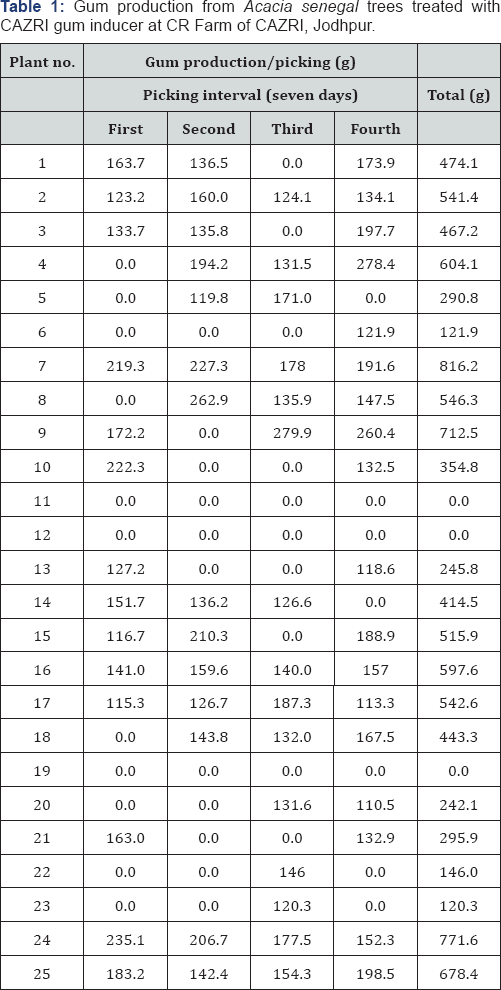
Selected twenty five plants of A. senegal were treated with CAZRI gum inducer to find out how gum Arabic is exuded (Table 1) . Selected plants were on uniform age (14 years) and had collar diameter in a range between 26.5 -32.8 cm. The height of plants also did not very much, average height of plants was 5.4 m. Results revealed that 85 % plants responded to gum inducer treatment. Four times picking was done at weekly interval after CAZRI gum inducer treatment. During first picking on an average 90.7 g gum Arabic /tree was obtained which was 94.5g gum Arabic /tree was during second picking and 93.4 g gum Arabic/ tree during third picking. Maximum gum Arabic (119.1 g/tree) was collected in the fourth picking. After that gum production was stopped in 88% of trees and in rest of trees even if gum is exuded, it was almost negligible in quantity. Thus, after treatment of CAZRI gum inducer gum exudation continued up to maximum one month. It was also noticed during the study that some plants continued to produce gum up to fourth picking, while some plants gave gum only in one picking. Origin of germplasm through which the plants raised were not known and therefore, perhaps genetic constitution of different trees may have certain differences. Perhaps this may be reason behind the phenomenon that some trees exuded gum continuously up to fourth picking and some did not show this pattern. Diallo et al. [9] found that based on the diploid trees it can be concluded that heritability in gum Arabic production is low to high with presence of high levels of additive genetic variation.
Effect of Management Practices Coupled with CAZRI Gum Inducer Treatment on Gum Arabic Production in Rocky Land Form
The results of the experiment are given in (Table 2). In case of control (traditional practice -making blazes on tree trunk) the gum production was negligible. However, two fortnightly flood irrigation (one 30 days before gum inducer treatment and second 15 days before gum inducer treatment) before treatment resulted in production of gum to the tune of 20 g/tree in case of half concentration of the normal dose treatment and 46 g/tree in case of normal dose treatment.
Only manuring (at the onset of monsoon of previous year) of the trees resulted in production of 29 and 34 g gum/tree in half concentration of normal dose treatment and normal dose treatment, respectively. When manuring (at the onset of monsoon of previous year) was done with flood irrigation as per schedule mentioned above, a very interesting result was obtained. It was found that gum production was 60 g/tree when half concentration of normal dose was applied which was higher than even normal dose treatment. This clearly showed with little tree management in form manuring and irrigations, the concentration of active ingredients of gum inducer can be reduced to the half (390mg ethephon/2 ml of solution) of normal strength (780 mg/4 ml of solution). This also indicated that in stressed condition of rocky lands even if concentration of active ingredient of CAZRI gum inducer is reduced to half, 60 g gum Arabic/tree can be obtained. On an average 18 trees of A. senegal / ha is found in such habitat, stakeholders can harvest 1.08 kg gum Arabic from one ha which can provide a return of Indian Rs. 1200/ kg (US $18.46).
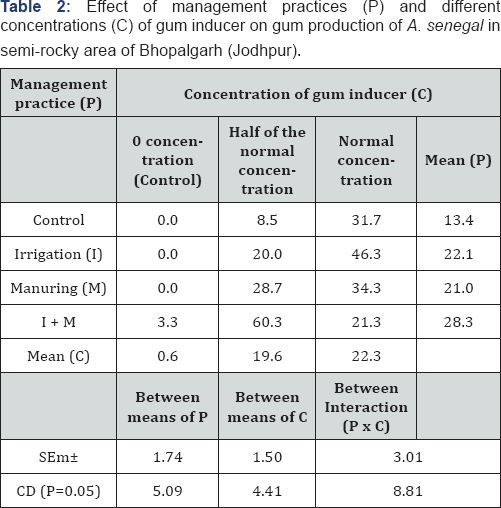
Moreover, when simple blazes were made on tree trunk (control), the plants produced almost negligible gum Arabic. This indicated that in rocky and semi-rocky areas where A. senegal grows in abundance, tree management practices coupled with gum inducer application can be effective for gum Arabic exudation. As already stated that about 12152 sq km area in arid western Rajasthan is rocky and A. senegal is main tree contitutent of such land formation. Such land forms can enhance the stakeholder's income by way of gum Arabic production through use of management practices and CAZRI gum inducer. Tewari et al. [12] found similer results while working on gum Arabic production in rocky-gravelly land form. Because trees remain in very stressed environmental condition in rocky- gravelly areas therefore reduction in CAZRI gum inducer doses was thought off.
Gum Production from A. Senegal in Relation to DBH of Trees
A study of gum exudation in relation to different girth classes in A. Senegal was carried out at CAZRI research farm. Girth and gum yield were recorded after treatment of CAZRI gum inducer. Gum yield was monitored at regular intervals (Figure 2) . Standardized does of CAZRI gum inducer was given to every single tree in each group. After treatment, maximum average gum yield (335g) were obtain from DBH group (31-40 cm) followed by DBH group of 41-50 cm, (average gum yield 235 g). In case of DBH group of 20-30 cm, average gum yield was 210 g. From the study it appeared that girth had no relation with gum yield. It is evident from (Figure 2) that 31-40 cm and 41-50 cm DBH classes produced maximum gum Arabic. Beyond these classes gum yields showed more or less decreasing trends. It appears that there is some genetic X environmental effects which also play some role in production of gum. [11].
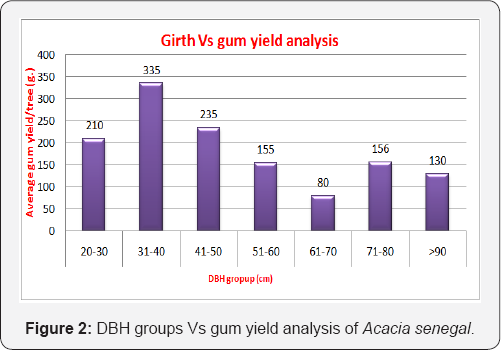
Temperature Vs Gum Yield
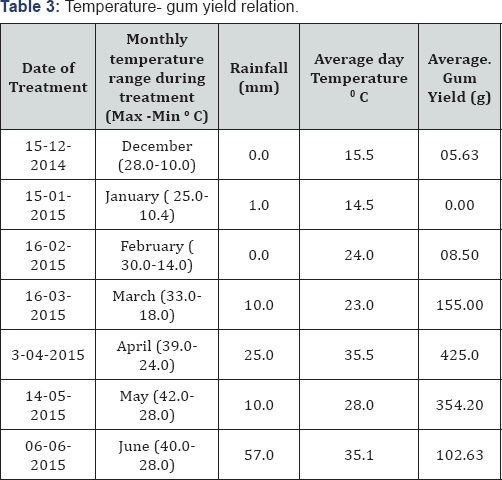
Temperature and gum yield were recorded after treatment of CAZRI gum inducer at regular intervals (Table 3). Data indicated that maximum gum Arabic production from A. Senegal occurred after treatment when average day temperature ranged from 300C-350C. Surprisingly, during month of June when temperature was in said range, the gum production was maximum. However, in the month of June though there was 57 mm rain fall occurred in a single day in the first week of June but after that there was no rainfall and temperature was high coupled with low humidity. It appeared this dry climatic situation resulted in better gum Arabic production; otherwise gum production in month of June generally decreases drastically [10]. After the month of June, gum Arabic exudation was not recorded at all.
Gum production on different land forms of arid zone
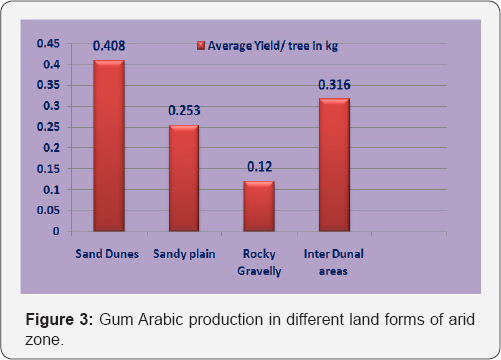
Gum exudations started five- ten days after treatment of sand dunes and inter dunal areas. In case of sandy plain formation, gum exudation started after seven days of treatment, and in case of inter dunal areas, gum exudation initiated 10 days after the treatment. Gum exudation process started after 13- 14 days in case of rocky- gravelly land form. Gum Arabic production was found maximum on sand dunes followed by inter dunal areas (Figure 3). Minimum gum Arabic production was recorded in rocky- gravelly land form. Though low gum yield in rocky-gravelly areas was in expected line however, it was very interesting that production of gums on sandy plains and inter dunal areas was 21.9% and 61.3% lower than gum yield on the sand dunes. This indicated that maximum gum Arabic can be harvested from the A. Senegal trees growing on sand dunes. About five decades back, Kaul & Chitinis [12] while working with traditional methods of gum harvesting through blazing the tree also found that A. Senegal produces maximum gum Arabic on sand dunes. We have observed in rocky landform by irrigating A. Senegal trees gum Arabic production was increased. Sand dunes also contain moisture below 25 cm after rainfall up to winter season and even in summer season moisture is available below 50 cm. This may perhaps major reason for higher gum Arabic production from A. Senegal tree on sand dunes.
Extension and adoption of CAZRI gum exudation technology
The technology of exudation of gum Arabic through CAZRI gum inducer has been well established. It has spread far and wide in arid western Rajasthan and as well as in other parts of the state. In addition to Rajasthan state, stakeholders from Haryana, Gujarat, Madhya Pradesh and Maharashtra state of India have shown keen interest on gum exudation technology of CAZRI. Farmers' are earning good amount of money by way of sale of gum Arabic in local market of arid western Rajasthan. In more than 45 villages, farmers of Chauhatan and Baytu tehsils of Barmer district; Shergarh and Phalodi tehsils of Jodhpur district; and some villages of Nagaur and Pali districts have adopted the gum inducing technology in large scale. Since last five years stakeholders, mainly farmers have treated 187.53 thousands trees of A. senegal by CAZRI gum inducer and produced gum Arabic to the tune of 76.35 t which gave an additional income to the stakeholders 48719 thousands Indian Rupees (65 Indian Rupees = 1.0 USD $).
Moreover, the preparation of CAZRI gum inducer is in public domain and many other players are also providing gum inducer to stakeholders. We estimated that the if same amount of gum inducer as sold by CAZRI was provided by other players to the farmers/ other stakeholders there must be more then the double numbers of tree (375 thousands) of A. senegal would have been treated to harvest gum Arabic in last five years [13]. This would have resulted in the production of gum Arabic at least to the tune of 153 t which must have been given an additional income to the stakeholders around Indian Rupees 97438 thousand. These data indicated that arid western Rajasthan is in a position to become gum Arabic production hub if CAZRI gum inducer technology is up-scaled through an appropriate outreach programme with participation of State Agriculture Department, State Forest Department, Other line Department and NGOs [14].
Conclusion
The procedure employed in the present study causes no injury to trees of A. senegal. In case of traditional method by blazing the tree stems, in one hand the gum production is very low (30-40 g/tree) and on the other trees are injured to very high extent, which even some time causes large scale mortality. Results obtained during the present course of experimentations indicated that gum Arabic exudation after treatment of CAZRI gum inducer continued up to one month or little more. On an average by using CAZRI gum inducer technology gum yield was 397.7 g/tree obtained. In rocky land forms where A. senegal is only tree component gum Arabic can also be harvested by using this technology. It was also observed that there is no relation between tree basal area and gum exudation. Maximum gum yield is observed where average day temperature ranged between 300C-350C [15]. In arid western Rajasthan A. senegal is found on different land forms. Results of our experimentations indicated that maximum gum Arabic was exuded on sand dunes followed by internal dunal areas. CAZRI gum exudation technique was adopted in large scale by stakeholders of Barmer, district of Rajasthan. We can easily conclude this district has potential for declaring gum garden of Rajasthan by state Government of Rajasthan.
Gum Arabic is a commercially important commodity which is used in food industries, dairy products, bakery products, flavour fixative, beverages and in pharmaceutical industry for processing many preparations. The market cost of pure gum Arabic in India ranged from Rupees 1200-1500/ kg (18.46 - 23.7 US $/ kg). It has many others application ranging from cosmetics to textile. If CAZRI gum inducing technology is applied appropriately with vigorous outreach programmes, the species can be source of income it millions of people in Indian arid and semi-arid regions. The researches described in this paper if adopted precisely, the technology has potential to change scenario of gum Arabic production of India.
Acknowledgement
Research was funded by "Network project of Harvesting, Processing and Value addition of Natural Resins and Gums" Indian Institute of Natural Resins and Gums, Namkum, Ranchi, India. We thank to Coordinator of the project and Director, IINRG, Namkum, Ranchi for their support.
References
- Champion HG, Seth SK (1968) A Revised Survey of the Forest Types of India. Delhi: Manager of Publications, India.
- FAO (1999) Compendium of food additives specifications. Rome: FAO. Food and nutrition paper 52, addendum 7, Gum Arabic, Rome, Italy, UN.
- Tewari JC and Pareek K (2016) Annual Progress Report on Network Project on Harvesting, Processing and Value Addition of Natural Resins and Gums, CAZRI Centre, ICAR-CAZRI, Jodhpur, Rajasthan, India, p. 26.
- Hocking D (1993) Trees for Dry lands. Oxford and IBH Publishing Co Pvt. Ltd, New Delhi, India, pp. 370.
- UN data (2011) United nations statistics Division, UN.
- Hall MA, Smith AR (1995) Ethylene and the responses of plants to stress. Bulg J Plant Physiol 21(2-3): 71-79.
- Tewari JC, Sharma AK, Narain P, Singh R (2007) Restorative forestry and agro forestry in hot arid region of India: A review. Journal of Tropical Forestry 23: 1-16.
- Narian P and Tewari JC (2005) Trees on agricultural fields: a unique basis of life support in Thar desert. In Multipurpose Tree in Tropics: Management and Improvement Strategies.
- Diallo AM, Nielsen LR, Hansen JK (2015) Study of quantitative genetics of gum Arabic production complicated by variability in ploidy level of Acacia senegal (L.) Willd Tree Genetics & Genomes 11(80): 1-13.
- Tewari JC and Pareek K (2012) Annual Progress Report on Network Project on Harvesting, Processing and Value Addition of Natural Resins and Gums, CAZRI Centre, ICAR-CAZRI, Jodhpur, Rajasthan, p. 17.
- Ram M, Tewari JC and Harsh LN (2012) An Improved Gum Tapping from Acacia senegal: An Option for Better Livelihood. LAP Lambert Acedemic Publishing Company, Saarbrucken, Germany, p. 78.
- Kaul RN and Chitnis BK (1964) Kummat-the tree of the rocky desert Indian Farming 13(12): 9-10.
- Srivastava (MoEF Gol APAFRI Goethe-Institute, Max Muller Bhwan,New Delhi; DST, GoI: National Medicinal Plant Board, New Delhi), AridForest Research Institute,jodhpur,Rajasthan,India,pp.516-523
- Tewari JC, Kumar S, Ratha Krishnan P, Ram Moola, Sharma AK (2012) CAZRI's Experiences with Ethephon Induced Gum Exudation: Research and Development in Arid Regions. CAZRI, Jodhpur, Rajasthan, India, p.15.
- Bhatt JR, Ram Mohan YH(1990) Ethephon-induced gum production in Acacia Senegal and its potential value in the semi-arid regions of India.Current Sc. 59(23): 1247-1250.






























